Last Updated on April 23, 2023
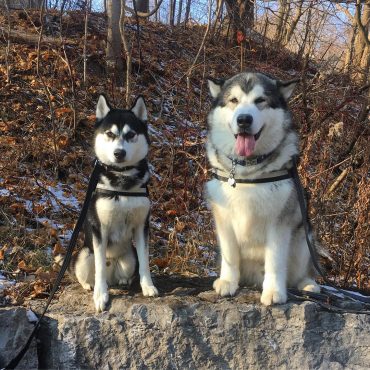
Ever seen a Husky-like dog but couldn’t tell if it really was a Siberian Husky?
You were probably looking at one of its cousins, probably an Alaskan Malamute or an Alaskan Husky.
These three dogs share a wolf-like appearance and a sled dog heritage. However, they each have characteristics that make them unique.
Let me tell you all about the similarities and differences between three of the most popular Northern breeds today
Quick Navigation
- 1 Similar looks, different backgrounds
- 2 The features of the Alaskan Malamute vs the Huskies
- 3 The personalities of these Arctic dogs
- 4 Alaskan Malamute vs Siberian and Alaskan Husky: which is easiest to groom?
- 5 Feeding a Husky vs feeding a Malamute
- 6 Which of these Northern breeds is prone to more health issues?
- 7 The price of a Malamute puppy vs. the cost of a Husky puppy
- 8 A comparison table of the Alaskan Husky vs the Siberian Husky vs the Alaskan Malamute
- 9 So, will it be a Malamute, a Siberian Husky, or an Alaskan Husky?
- 10 Reference
Similar looks, different backgrounds
The Alaskan Malamute, Siberian Husky (Sibe), and Alaskan Husky are all sled dogs, bred for speed, endurance, and strength. You’d think they’d have the same background, too, but that’s where you’d be mistaken.
Here’s a quick history lesson so you can learn all about where these hardworking dogs came from.
The origin of Malamutes
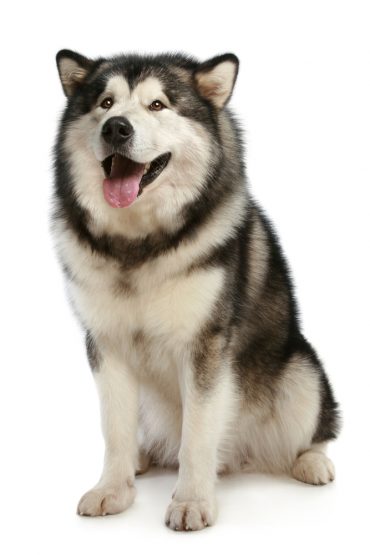
Did you know that a 2013 study identified the Alaskan Malamute as a basal breed?
Like the Basenji and the Shiba Inu, Malamutes are thought to have existed before modern dog breeds emerged in the 19th century.
The Malamute got its name from the nomadic Inuit tribe called Mahlemuts.
Trained as an all-around or utilitarian dog, the breed was considered an excellent hunter able to take down big game such as bears and seals.
The breed became extremely popular during the Klondike Gold Rush of 1896, as prospectors and settlers needed a dog strong enough to pull heavy freight.
People began to cross the Malamute with other dogs in the hope of replicating the purebred’s strength.
The interbreeding became uncontrollable. It came to the point that the ancient DNA of Malamutes almost disappeared.
Fortunately, a breeder named Robert J. Zoller became involved in the breed’s revival, creating the Husky Pak line of dogs.
All modern Malamutes are thought to be descended from early strains of this line.
The history of Siberian Huskies
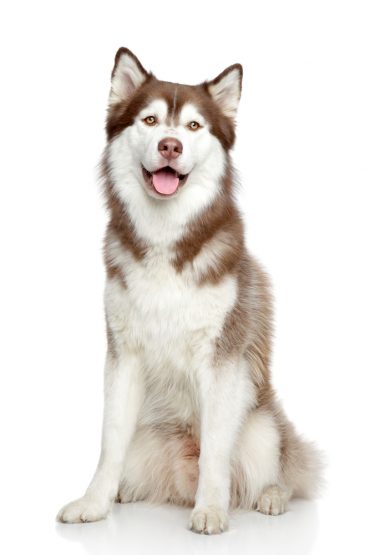
Siberian Huskies, on the other hand, have roots in Eurasia.
Directly descended from the original sled dog, these hardy canines were originally developed by the Chukchi tribe in eastern Siberia.
Huskies were bred to endure long travels in harsh, extremely cold weather. They were not only sled dogs, but they also helped in hunting prey and the herding of livestock.
Many of them even helped explore uncharted territory, helping tribes look for potential settlements.
The breed has always been raised in a family setting, which is why they have such a gentle, friendly temperament.
In 1909, the Siberian Husky came to America to compete in the All Alaska Sweepstakes, a famous sled-dog race.
The competition cemented the Huskies’ reputation when they finished third place.
Soon after, many competitors started having the dogs compete in the race because of their unbelievable speed and endurance.
The breed’s popularity skyrocketed when a team of Huskies completed the Great Race of Mercy in 1925, a run covering more than 600 miles of Alaskan territory.
What about Alaskan Huskies?
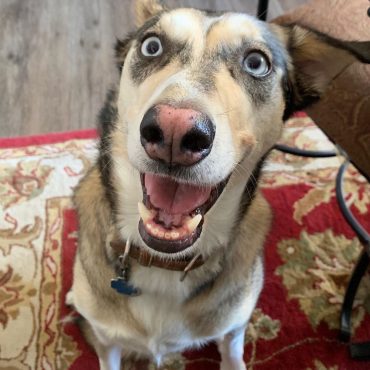
The question of “Alaskan Husky vs Siberian Husky?” is a common one. Let’s make some things clear, once and for all.
An Alaskan Husky is a type of dog rather than a breed. He’s a mix of the Malamute, Siberian Husky, Inuit Husky, Eskimo Dog, and German Shepherd, among other breeds.
These canines are bred purely for performance. They’re used as working dogs and, more commonly, as racing sled dogs.
Some are capable of distance racing, going as many as 1,000 miles in one race.
Alaskan Huskies have their own differences from Sibes. For one, the Alaskan Husky tends to be taller.
Alaskan Huskies are usually faster than their Siberian counterparts, too. They’re are unmatched among the Northern breeds when it comes to speed and endurance, so these Huskies are highly prized in the world of dogsled racing.
The features of the Alaskan Malamute vs the Huskies
These sled dogs share a similar look. Their coat colors and facial markings tend to be the same. Their fluffy tails, which they tuck over their noses for warmth, also curl up over the back.
However, there are differences in the appearance of these three dogs. If you take a closer look, you’ll be able to spot a few distinct characteristics in each breed.
Check out this video of an Alaskan Malamute and a Siberian Husky playing and try to tell which is which:
Malamutes are bigger than Siberian and Alaskan Huskies
There’s a marked difference between these dogs when it comes to size, with the Malamute usually being much bigger than the Siberian and Alaskan Huskies. You’ll easily notice the difference if you look at a Malamute and a Husky side by side.
Bred for strength, an Alaskan Malamute can be classified as a large to giant breed. A female Malamute’s height plays between 22 to 24 inches (55 to 63 cm) and weighs 71 to 84 lbs (32 to 38 kg).
The height of male Malamutes ranges from 24 to 26 inches (63 to 66 cm) and they can weigh as much as 95 lbs (43 kg). There are also Malamutes that can stand up to 35 inches tall and weigh more than 100 lbs!
Siberian Huskies, on the other hand, tend to be more slender. They were bred for faster movement and maximum stamina; that’s why they range only from medium to large size.
A female Siberian can measure between 20 to 22 inches (50 to 55 cm) in height and weigh between 31 to 51 lbs (14 to 23 kg), while male Sibes can reach up to 24 inches (63 cm) tall and weigh anywhere from 44 to 60 lbs (19 to 27 kg).
As we’ve mentioned, Alaskan Huskies are taller than their Siberian cousins, as many of them reach a height of up to 26 inches (66 cm). The two Huskies usually share the same lean build.
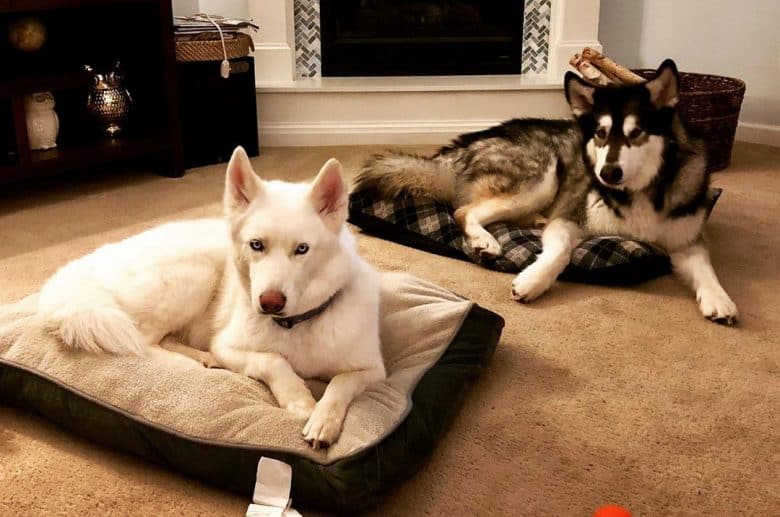
They have different eye colors.
Huskies and Malamutes have striking almond-shaped eyes that seem like they’re staring right through your soul – a trait that endears both breeds to many owners.
But while Malamutes and Alaskan Huskies have eyes that are different shades of brown, Siberian Huskies can have eyes in more colors, including brown, blue, black, or green.
Some Sibes even have parti-colored (two colors in one eye) or bi-colored (each eye is a different color) eyes. The latter is also known as heterochromia.
The personalities of these Arctic dogs
When it comes to temperament, the Malamute and Alaskan and Siberian Huskies have a few differences. But, first, let’s talk about what these dogs have in common.
Being pack-oriented dogs, the Malamute and Huskies share a sociable nature. They’re usually friendly around people, and they love being the center of attention. Family members can expect a lot of cuddles from these dogs.
They’re highly intelligent canines, resourceful and independent. Training any of them will definitely be an interesting experience.
Don’t expect a Malamute or a Husky to follow your commands all the time, as they easily get bored.
In addition to being stubborn, the Malamute and Siberian will have a hard time staying calm around smaller animals because of their high prey drive.
The Alaskan Husky, on the other hand, may not give chase to the neighbor’s cat or your pet bunny because he has little to no background as a hunter.
Compared to the Huskies, a Malamute tends to be a more dignified creature. With this attitude come an aloofness or even an aggression around other dogs, especially of the same sex. This characteristic is caused by the breed’s strong pack nature.
Are they suitable for first-time dog owners?
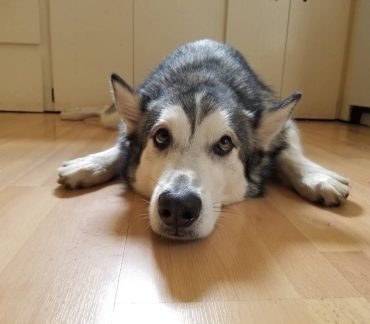
The truth is that any of these three dogs will be challenging for a first-time dog owner.
If you’re looking for your first four-legged, furry buddy, you may want to look for a breed that’s easier to train.
Malamutes and Huskies need to know who the alpha of the pack is, and they will try to assert dominance if they don’t see one.
Unless these dogs see you as the alpha, you can’t expect them to obey a simple command like “sit”.
It’s up to you to establish yourself as the pack leader as early as possible. This will make training significantly easier.
They also have high energy levels, so they need plenty of exercise. Expect to give your Malamute or Husky at least one to two hours of vigorous physical activity daily. Mental stimulation is important for these canines, too.
If they get bored or don’t release their pent-up energy, they’ll resort to destructive behavior like chewing up your shoes or furniture.
Do they make good guard dogs?
The short answer is: NO.
None of these three dogs will be reliable as a guard dog; they’re too friendly to have a protective instinct. The Siberian and Alaskan Huskies will greet strangers with a happy expression and a wagging tail, like they would a family member.
So is the Malamute a better guard dog or watch dog? Not really. Malamutes love getting attention, and they won’t be able to resist pats or belly rubs from strangers.
With their wolf-like features (and the Malamute’s impressive size), these dogs may be effective as a visual deterrent for intruders, but that’s the extent of their guard dog abilities.
Are they good family dogs?
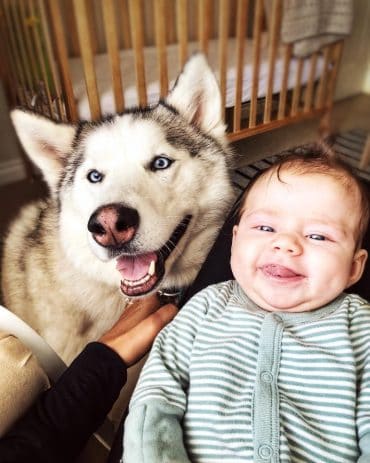
The Alaskan Malamute and the Siberian and Alaskan Huskies are suitable pets for the family.
They’re pack-oriented dogs, so they crave companionship and will love spending time with their family.
Their gentle nature makes them particularly good around kids. Sibes were trusted by the Chukchi even around babies and young children.
Just a heads-up, though: Malamutes may have some aggression issues around other dogs.
Early socialization can help prevent problems between a Malamute and other canines in the household.
Malamutes may also be more suitable for families with older children. Given this breed’s size, he can easily knock down a small child and inadvertently cause accidents during playtime.
Alaskan Malamute vs Siberian and Alaskan Husky: which is easiest to groom?
There’s not much difference when it comes to the grooming and maintenance of Malamutes and Huskies.
All three dogs have a double-layer coat composed of an undercoat and a topcoat. The thickness of their coats protects them from freezing temperatures and reflects heat in the summer.
Siberian and Alaskan Huskies’ fur is usually short to medium-length, while the Malamute will have longer and thicker fur. They all have similar shedding pattern, though: they blow their coat twice a year, usually with a major season change.
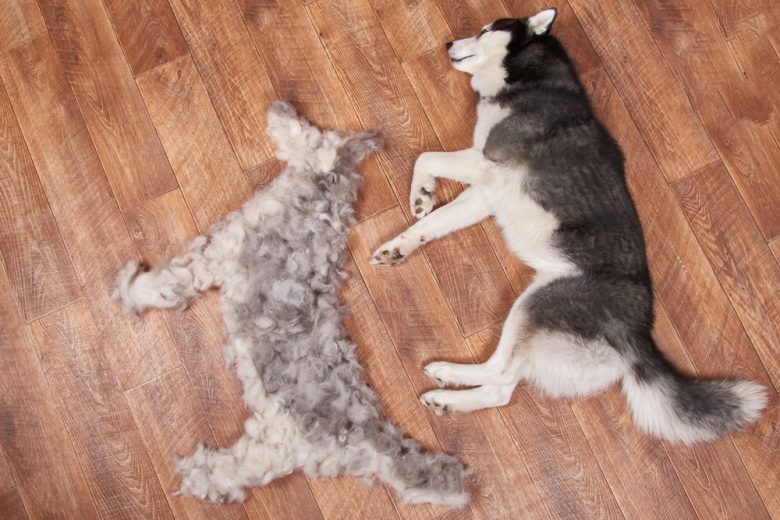
This intense shedding period can last up to 3 weeks, during which the dog’s undercoat will fall off in large clumps. You need to brush the coat once to thrice daily to remove loose fur from the coat.
If you don’t want a house completely covered in fur, be sure to ready your vacuum cleaner and high-quality brushes.
Devote yourself to a brushing schedule and you’ll see a glossy and healthy looking coat on your Malamute or Husky.
One great thing about these dogs is that their coats are essentially self-cleaning. They don’t develop odor or accumulate dirt like other double-coated breeds. You may even get away with bathing your dog just once a year.
Feeding a Husky vs feeding a Malamute
Due to their nature as sled dogs, Huskies and Malamutes tend to share the same dietary requirements.
These dogs can survive and work off little food. They’re usually given small amounts of high-calorie food rich in protein and fat. This diet keeps the dogs’ muscles and bones strong and sustains their energy levels throughout the day.
Thanks to their metabolism, Malamutes and Huskies can get by with less food compared to other breeds their size. They’ll be just fine with 2 to 4 cups of dry kibble daily, divided into 2 meals.
Huskies are known to stop eating when they are full. On the contrary, Malamutes are notorious for their voracious appetite. A Malamute will keep eating as long as you keep giving it food; this makes the breed more prone to obesity.
Which of these Northern breeds is prone to more health issues?
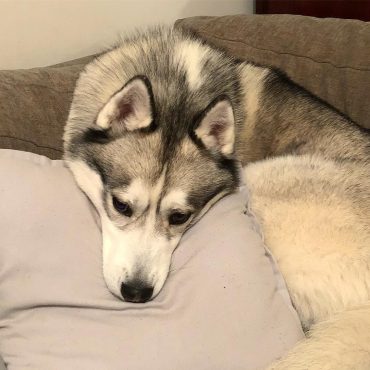
Huskies and Malamutes are considered to be some of the healthiest breeds today. These dogs are all equally healthy, especially compared to dogs their size.
However, these dogs can still acquire health problems, most of which are genetic.
Many Malamutes and Huskies suffer from hip dysplasia and eye problems such as cataracts and progressive retinal atrophy.
Alaskan Huskies can also develop hypothyroidism, while Sibes can experience seizures and congenital laryngeal paralysis.
An Alaskan Malamute can live up to 12 years while the Siberian and Alaskan Huskies can live up to 14 years and 15 years, respectively.
The price of a Malamute puppy vs. the cost of a Husky puppy
Malamute and Husky puppies usually come at different prices, with the costs varying depending on factors like lineage and gender. Show-quality Huskies will also be more expensive compared to pet-quality pups.
On average, a Malamute puppy will cost $1000, while Siberians may cost around $800 to $2500. Alaskan Husky pups may be sold by breeders at $1000 to $1500 each.
Superior-pedigree puppies from these breeds may have price tags upwards of $6500.
Malamute and Husky breeders you can trust
Finding breeders of Malamutes and Huskies won’t be a problem, as these are popular dogs. The trick is locating a trustworthy breeder who will provide you with a puppy that has a clean bill of health.
It’s always best to check with clubs like the Alaskan Malamute Club of America, the Siberian Husky Club of America, or even the American Kennel Club for affiliated breeders.
Here are some breeders you can trust:
Kalamals Alaskan Malamutes (Virginia) – This breeder has been producing champion-line Malamutes since 1989. Focused on breeding physically and mentally sound Mals, they have produced over 26 champions from their line.
Harvest Moon Malamutes (New York) – If you are looking for Giant Malamutes, this breeder is the perfect find. Their family-run breeding program is focused on producing the best M’loot Giant Alaskan Malamute lines today.
Bama Huskies (Alabama) – Bama Huskies offers Siberian Husky puppies from champion bloodlines. This breeder has a spacious kennel and whelping area, climate-controlled feed rooms, and even its own healthcare lab for Husky pups.
Loyal Siberian Husky (South Carolina) – This breeder has been producing top-quality purebred Siberians since 1992. They guarantee that each of their puppies is registered with the AKC and compliant with USDA regulations.
Deer Creek Sleddogs (Wyoming) – Deer Creek started out with rescuing Siberians and having them compete in races, eventually branching out to Alaskan Huskies. In addition to racint these sled dogs, they also occasionally put up Alaskan Husky litters for sale.
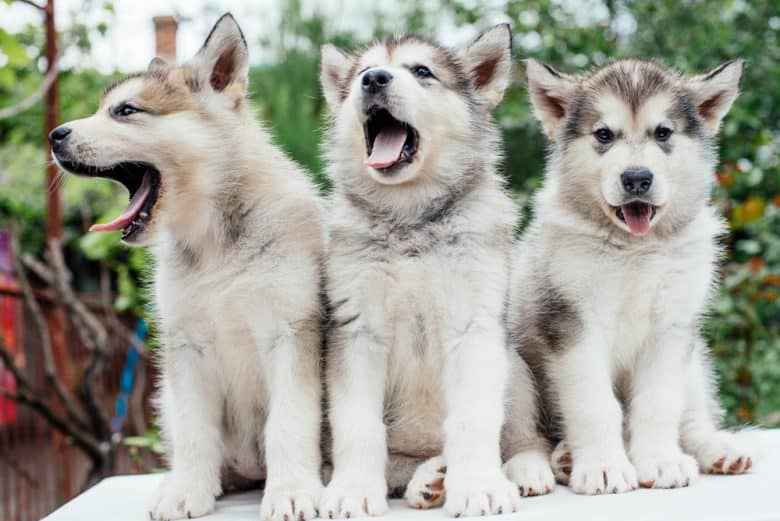
Adopting Malamutes and Siberian and Alaskan Huskies
The number of abandoned Huskies and Malamutes has significantly risen since 2010, and shelters attribute the increase to the show Game of Thrones.
Without proper preparation and knowledge about these breeds, fans of the show are buying Huskies and Malamutes because of their resemblance to direwolves.
Why not give these abandoned dogs a second chance at a loving home? Adoption will also be more affordable compared to getting a pup from a breeder.
You can start your search here:
Arctic Rescue (Utah and Colorado) – Most of their rescues are northern breeds, including Huskies and Malamutes. They save almost a 100 relinquished sled dogs a year.
NorSled (California) – This shelter also specializes in rescuing, rehabilitating and fostering Huskies, Malamutes, Samoyeds, and other similar breeds.
Free Spirit Siberian Rescue (Illinois) – Founded in 1999, this organization is focused on reducing the number of homeless Siberian Huskies. Since its founding, it has rehomed more than 1000 Huskies.
A comparison table of the Alaskan Husky vs the Siberian Husky vs the Alaskan Malamute
| Traits | Alaskan Husky | Siberian Husky | Alaskan Malamute |
| Purebred? | No | Yes | Yes |
| Size | Up to 26 inches (66 cm)
40 to 60 pounds (21 to 25 kg) |
Up to 24 inches (63 cm)
44 to 60 lbs (19 to 27 kg) |
24 to 26 inches (63 to 66 cm)
Up to 95 lbs (43 kg) (biggest) |
| Eye color | Any color but often brown | Brown, blue, green, parti-colored, bi-colored | All shades of brown |
| Coat | Double coat, short to medium-length | Double coat, short to medium-length | Double coat, long |
| Good with kids? | Yes | Yes | Yes (supervision needed because of his size) |
| Friendly with people? | Yes | Yes | Yes |
| Good guard dogs? | No | No | No |
| Gets along well with other pets? | Yes | Yes | Needs more socialization with other dogs |
| Prey drive | Moderate | High | High |
| Energy levels | High | High | High |
| Lifespan | 10 to 15 years | Up to 14 years | Up to 12 years |
| Average price per puppy | $1000 to $1500 | $800 to $2500 | $1000 |
So, will it be a Malamute, a Siberian Husky, or an Alaskan Husky?
When it comes to the debate of ‘Malamute vs Husky’, there’s no clear winner. Each of these dogs is unique in its own way.
No matter which one you choose, what’s important is that you’re adequately prepared to meet its needs, especially when it comes to training and exercise.
What these three have in common is that they’re high-energy breeds, so they’ll need plenty of physical activity.
They’re also smart dogs, so they’ll easily get bored of repetitive training routines.
One distinct difference between these breeds is that Malamutes are considerably larger than Siberian and Alaskan Huskies.
You’ll have to take that into consideration when it comes to the dog’s living space.
What do you think about these sled dogs? Share your thoughts with us by commenting below!
Reference
- https://www.britannica.com/animal/Siberian-husky
- https://vcahospitals.com/know-your-pet/laryngeal-paralysis-in-dogs
- https://awoiaf.westeros.org/index.php/Direwolf
Cess is the Head of Content Writing at K9 Web and a passionate dog care expert with over 5 years of experience in the Pet Industry. With a background in animal science, dog training, and behavior consulting, her hands-on experience and extensive knowledge make her a trusted source for dog owners.
When not writing or leading the K9 Web content team, Cess can be found volunteering at local shelters and participating in dog-related events.
